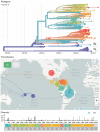Nextstrain: real-time tracking of pathogen evolution
- PMID: 29790939
- PMCID: PMC6247931
- DOI: 10.1093/bioinformatics/bty407
Nextstrain: real-time tracking of pathogen evolution
Abstract
Summary: Understanding the spread and evolution of pathogens is important for effective public health measures and surveillance. Nextstrain consists of a database of viral genomes, a bioinformatics pipeline for phylodynamics analysis, and an interactive visualization platform. Together these present a real-time view into the evolution and spread of a range of viral pathogens of high public health importance. The visualization integrates sequence data with other data types such as geographic information, serology, or host species. Nextstrain compiles our current understanding into a single accessible location, open to health professionals, epidemiologists, virologists and the public alike.
Availability and implementation: All code (predominantly JavaScript and Python) is freely available from github.com/nextstrain and the web-application is available at nextstrain.org.
Figures
Comment in
-
Evolutionary consequences of delaying intervention for monkeypox.Lancet. 2022 Oct 8;400(10359):1191-1193. doi: 10.1016/S0140-6736(22)01789-5. Epub 2022 Sep 21. Lancet. 2022. PMID: 36152668 Free PMC article. No abstract available.
References
-
- Croucher N.J., Didelot X. (2015) The application of genomics to tracing bacterial pathogen transmission. Curr. Opin. Microbiol., 23, 62–67. - PubMed
Publication types
MeSH terms
Grants and funding
LinkOut - more resources
Full Text Sources
Other Literature Sources


